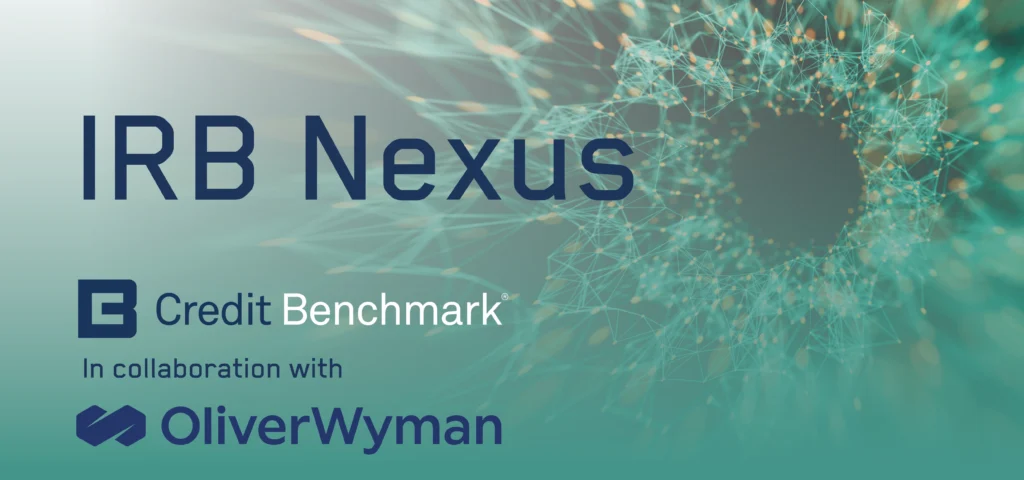The IRB Nexus solution offers data to enhance risk models
IRB Nexus, developed by Oliver Wyman in collaboration with Credit Benchmark, enhances risk modeling by aggregating data from 40 banks, providing over 10 million risk estimates annually.
As banks rebuild their internal ratings-based (IRB) models to comply with updated regulatory requirements, many are finding it hard to demonstrate the validity of their risk models. A major challenge is a lack of sufficient credit analytics, especially for low-default and no-default portfolios, as individual banks often have a limited number of counterparties and default cases. Such counterparties include private funds and other strategic businesses that global supervisors monitor due to their increased systemic risk, as well as project finance exposures, which are crucial for developing the significant amount of green infrastructure needed to address the climate agenda.
Given the lack of defaults, banks have little evidence of the potential conditions under which their borrowers might or might not default in future. That makes it hard to satisfy the supervisory requirements, which can lead to demands that the banks retain more capital to back up their loans. This reduces the amount they can lend out in these businesses, so they face losing competitive advantage to their peers or non-banks, which generally have less stringent regulations on capital requirements.
Oliver Wyman’s new European credit analytics solution, IRB Nexus, remedies this problem. In collaboration with Credit Benchmark (CB), the financial data analytics company, IRB Nexus gathers a wider range of data than is normally available to banks. It then combines these with credit risk analytics. This use of collective data enables an individual bank to better develop a risk model or demonstrate the robustness of its model’s assumptions. Thus, the bank is more likely to satisfy the regulator.
Oliver Wyman Partner Cem Dedeaga and Credit Benchmark CEO Michael Crumpler talked to Maike Wiehmeier, Oliver Wyman’s head of marketing acceleration, Europe, about the new solution.


Michael Crumpler, CEO, Credit Benchmark
Cem Dedeaga, Partner, Oliver Wyman
Where did the idea for IRB Nexus come from?
Cem: Many banks are taking an internal ratings-based model to evaluate credit risk: They estimate their own risk levels to calculate the capital they need to hold. But the bar for complying with the regulations has been rising in recent years with the introduction of more detailed guidance. This is especially having an impact on low-default and no-default portfolios, where traditional approaches were deemed compliant in some jurisdictions but are now being challenged.
Credit Benchmark was an obvious candidate to provide this data, as it provides access to data from a large set of banks — many of which use IRB models — and has the ability to identify historical default events.
What is Credit Benchmark’s role in helping banks comply with IRB model regulations?
Michael: We work with major, global financial institutions to collect, anonymize and aggregate their internal credit evaluations. This aggregated data is based on a wider range of evaluations than institutions normally have available, so it provides a broader, deeper view of creditworthiness for companies and industries. Some of the financial institutions that use the aggregated data are among those that contributed their data to us. Others — such as asset management firms and insurance companies — are subscribers: They don’t contribute data, but they buy access to the consensus data and use them for insights.
How extensive is the data aggregated by Credit Benchmark?
Michael: More than 40 banks have contributed credit data to Credit Benchmark, adding up to a total of more than 10 million risk estimates each year. The firm thus analyzes over 100,000 counterparties for their probability of default, of which 90% are otherwise unrated. CB then makes the data available to banks as a service. This data enabled one bank to increase its historical default and non-default observations by five times. We have also made sure to harvest the data in a way that is easy to use. Financial institutions can use the results in various ways — for example, as early warning systems for banks.
Where did Oliver Wyman get the idea to work with Credit Benchmark?
Cem: We needed a comprehensive dataset that would be sufficiently representative of banks’ credit exposures. The data also had to be robust and based on credit processes comparable to those used by the IRB institutions seeking to use these external data, as well as being available at sufficient granularity for our users. The especially challenging segment for our use case is the corporate entities that do not have a public rating from the typical rating agencies. These rating observations have been used for training IRB models in the past and have passed regulatory scrutiny. We are aware of the high regulatory bar to satisfy both the internal validation and the supervisory requirements for using external data. Credit Benchmark had the potential to tick these boxes. Therefore, we went for the collaboration! Given the complementary propositions we bring to this product, we are also very happy to have agreed to an exclusivity arrangement with Credit Benchmark.
Beyond the Credit Benchmark data, what else does IRB Nexus consist of?
Cem: The underlying data is the starting point. But, given the supervisory expectations on data usage, you cannot simply take the data out and expect that it will pass the scrutiny of the supervisors. I’m sure those who work in the domain will appreciate that. This is where Oliver Wyman comes in, as we have gained expertise through a wealth of experience in the financial sector. We have carried out more than 300 projects globally in IRB modelling, the accuracy of risk-weighted assets, and IFRS 9. We also have regular interaction with more than 15 major global regulators.
Over the last 18 months, we have worked through Credit Benchmark’s available data, done an extended review of the assumptions and limitations, documented these, and produced analytics that can be used for the intended purpose. Our product delivery is end-to-end. We understand a client’s specific problem, whether this is demonstrating that the rating scorecard is robust, the calibration target appropriate — or whether their sample needs to be extended to a greater number of obligors. Then we deliver the needed analytical support. This can also include conservatisms to be added to the capital estimates and comprehensive accompanying documentation that is crucial from a model risk perspective.
Who are the primary clients for this service, and which types of exposures benefit the most?
Cem: We have helped banks over a number of issues so far. The most sought-after product concerns exposures to funds and non-bank financial institutions — this is where the need is most immediate, and alternatives are rarer. Institutions have also used the data to expand their modelling samples to areas in which they have limited exposure. For example, banks that are traditionally focused on a certain region have been positioning the product to extend their model approval to other geographies. We are also seeing interest in strategically important areas like Project Finance which are enablers of the climate agenda. Here, there is also potential to improve outcomes for banks and we are working through with a few banks on exploring the potential.
Have any banks already tried out IRB Nexus, and what were the results?
Michael: As of October 2024, we have worked with three institutions. One had developed a risk model based on its portfolio of funds, which had never defaulted, and its portfolio of non-bank financial institutions (insurers and pension funds) with a very low default rate. We worked with the bank to make an external dataset that was representative of its specific business portfolio. The bank then used this dataset to expand its internal modelling sample with additional observations. In this way, it demonstrated that its internal historical default rate estimates were robust.
Are there any competitors to IRB Nexus in the financial business services market?
Cem: The potentially adjacent offers are either serving other populations (for example, those with external ratings which limit the use case for this purpose) or do not have the granularity of analytics we are offering that is important for demonstrating compliance. Our aim is to follow the spirit of the supervisory rules as well as their letter. We believe our analytics service enables banks to measure their risk better than alternatives, using the Standardized RWA approach, which brings their own, arguably greater challenges such as providing the wrong incentives for bank lending.
What is the process for banks to use IRB Nexus?
Cem: We work in three steps. First comes an introductory meeting, so that we can understand the bank’s lending profile and assess the potential for using IRB Nexus. Secondly, we carry out a feasibility study, by cross-referencing the portfolio segmentation to Credit Benchmark’s database in more detail. We then provide a feasibility assessment demonstrating how the bank could satisfy its regulatory requirements — and one key requirement is that the data be representative.
The third step is product delivery. We provide a detailed modelling dataset, carry out accompanying analytics relevant to the client’s IRB model, and produce a purpose-built data document including specific assumptions and limitations. We also present an analysis of any adjustments that are needed.
What are the future development plans for IRB Nexus?
Michael: We envision the product as an ongoing service. The first step is for the client to get regulatory approval using the analytics we provide. Later, we will aim to provide annual analytics updates for clients’ portfolios and IRB models. But this is only the first product. Along with Oliver Wyman, we are working on various ideas for significant-risk-transfer (SRT) products, as well as ways to help banks better benchmark their model outputs to each other. We are also developing other models, including IFRS 9.
